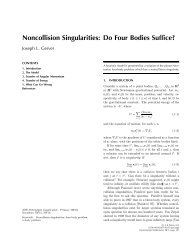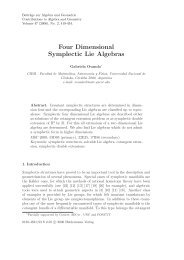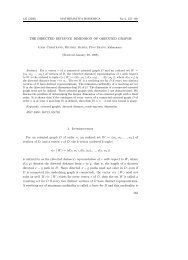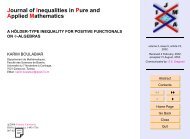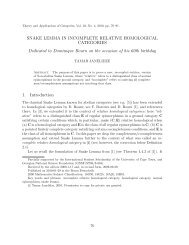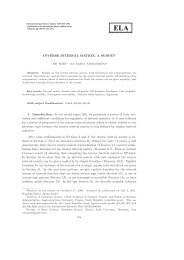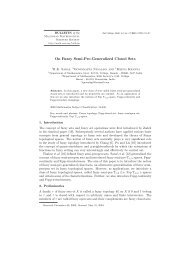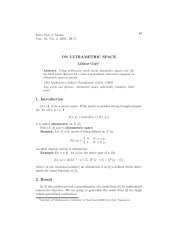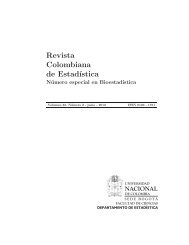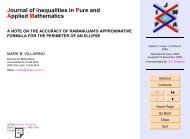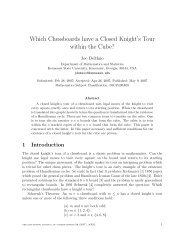Certain coefficient inequalities for sakaguchi type functions ... - EMIS
Certain coefficient inequalities for sakaguchi type functions ... - EMIS
Certain coefficient inequalities for sakaguchi type functions ... - EMIS
Create successful ePaper yourself
Turn your PDF publications into a flip-book with our unique Google optimized e-Paper software.
ACTA UNIVERSITATIS APULENSIS No 19/2009<br />
CERTAIN COEFFICIENT INEQUALITIES FOR SAKAGUCHI<br />
TYPE FUNCTIONS AND APPLICATIONS TO FRACTIONAL<br />
DERIVATIVE OPERATOR<br />
S. P. Goyal, Pranay Goswami<br />
Abstract. In the present paper, sharp upper bounds of |a 3 − µa 2 2 | <strong>for</strong> the<br />
<strong>functions</strong> f(z) = z + a 2 z 2 + a 3 z 3 + ... belonging to a new subclass of Sakaguchi <strong>type</strong><br />
<strong>functions</strong> are obtained. Also, application of our results <strong>for</strong> subclass of <strong>functions</strong><br />
defined by convolution with a normalized analytic function are given. In particular,<br />
Fekete-Szegö <strong>inequalities</strong> <strong>for</strong> certain classes of <strong>functions</strong> defined through fractional<br />
derivatives are obtained.<br />
2000 Mathematics Subject Classification: 30C50; 30C45; 30C80.<br />
Keywords: Sakaguchi <strong>functions</strong>, Analytic <strong>functions</strong>, Subordination, Fekete-Szegö<br />
inequality.<br />
1. Introduction<br />
Let A be the class of analytic <strong>functions</strong> of the <strong>for</strong>m<br />
∞∑<br />
f(z) = z + a n z n (z ∈ ∆ := {z ∈ C| |z| < 1}) (1.1)<br />
n=2<br />
and S be the subclass of A consisting of univalent<strong>functions</strong>. For two <strong>functions</strong><br />
f, g ∈ A, we say that the function f(z) is subordinate to g(z) in ∆ and write<br />
f ≺ g or f(z) ≺ g(z), if there exists an analytic function w(z) with w(0) = 0<br />
and |w(z)| < 1 (z ∈ ∆), such that f(z) = g(w(z)), (z ∈ ∆). In particular, if the<br />
function g is univalent in ∆, the above subordination is equivalent to f(0) = g(0)<br />
and f(∆) ⊂ g(∆).<br />
Recently Owa et al. [7,8] introduced and studied a Sakaguchi <strong>type</strong> class S ∗ (α, t). A<br />
function f(z) ∈ A is said to be in the class S ∗ (α, t) if it satisfies<br />
{ (1 − t)zf ′ }<br />
(z)<br />
Re<br />
> α, |t| ≤ 1, t ≠ 1 (1.2)<br />
f(z) − f(zt)<br />
159
S. P. Goyal, P. Goswami - <strong>Certain</strong> Coefficient Inequalities <strong>for</strong> Sakaguchi ...<br />
<strong>for</strong> some α ∈ [0, 1) and <strong>for</strong> all z ∈ ∆. For α = 0 and t = −1, we get the class<br />
the class S ∗ (0, −1) studied be Sakaguchi [9]. A function f(z) ∈ S ∗ (α, −1) is called<br />
Sakaguchi function of order α.<br />
In this paper, we define the following class S ∗ (φ, t), which is generalization of<br />
the class S ∗ (α, t).<br />
Definition 1.1. Let φ(z) = 1 + B 1 z + B 2 z 2 + ... be univalent starlike function with<br />
respect to ’1’ which maps the unit disk ∆ onto a region in the right half plane which<br />
is symmetric with respect to the real axis, and let B 1 > 0. Then function f ∈ A is<br />
in the class S ∗ (φ, t) if<br />
(1 − t)zf ′ (z)<br />
f(z) − f(zt)<br />
≺ φ(z), |t| ≤ 1, t ≠ 1 (1.5)<br />
Again T (φ, t) denote the subclass of A consisting <strong>functions</strong> f(z) such that zf ′ (z) ∈<br />
S ∗ (φ, t).<br />
When φ(z) = (1 + Az)/(1 + Bz), (−1 ≤ B < A ≤ 1), we denote the subclasses<br />
S ∗ (φ, t) and T (φ, t) by S ∗ [A, B, t] and T [A, B, t] respectively.<br />
Obviously S ∗ (φ, 0) ≡ S ∗ (φ). When t = −1, then S ∗ (φ, −1) ≡ Ss ∗ (φ), which is a<br />
known class studied by Shanmugam et al. [10]. For t = 0 and φ(z) = (1 + Az)/(1 +<br />
Bz), (−1 ≤ B < A ≤ 1), the subclass S ∗ (φ, t) reduces to the class S ∗ [A, B]<br />
studied by Janowski [3]. For 0 ≤ α < 1 let S ∗ (α, t) := S ∗ [1 − 2α, −1; t], which is a<br />
known class studied by Owa et al. [8]. Also, <strong>for</strong> t = −1 and φ(z) = 1+(1−2α)z<br />
1−z<br />
, our<br />
class reduces to a known class S(α, −1) studied by Cho et al. ([1], see also [8]).<br />
In the present paper, we obtain the Fekete-Szegö inequality <strong>for</strong> the <strong>functions</strong> in<br />
the subclass S ∗ (φ, t). We also give application of our results to certain <strong>functions</strong><br />
defined through convolution (or Hadamard product) and in particular, we consider<br />
the class S λ (φ, t) defined by fractional derivatives.<br />
To prove our main results, we need the following lemma:<br />
Lemma 1.2. ([4]) If p(z) = 1 + c 1 z + c 2 z 2 ... is an analytic function with positive<br />
real part in ∆, then<br />
⎧<br />
⎪⎨ −4v + 2 if v ≤ 0,<br />
|c 2 − vc 2 1| ≤ 2 if 0 ≤ v ≤ 1,<br />
⎪⎩ 4v − 2 if v ≥ 1.<br />
When v < 0 or v > 1, the equality holds if and only if p(z) is (1 + z)/(1 − z) or<br />
one of its rotations. If 0 < v < 1, then the equality holds if and only if p(z) is<br />
(1 + z 2 )/(1 − z 2 ) or one of its rotations. If v = 0, the equality holds if and only if<br />
p(z) =<br />
( 1<br />
2 + 1 2 λ ) 1 + z<br />
1 − z + ( 1<br />
2 − 1 2 λ ) 1 − z<br />
1 + z<br />
(0 ≤ λ ≤ 1)<br />
160
S. P. Goyal, P. Goswami - <strong>Certain</strong> Coefficient Inequalities <strong>for</strong> Sakaguchi ...<br />
or one of its rotations. If v = 1, the equality holds if and only if p(z) is the reciprocal<br />
of one of the <strong>functions</strong> such that the equality holds in the case of v = 0.<br />
Also the above upper bound is sharp, and it can be improved as follows when<br />
0 < v < 1:<br />
|c 2 − vc 2 1| + v|c 1 | 2 ≤ 2 (0 < v ≤ 1/2)<br />
and<br />
|c 2 − vc 2 1| + (1 − v)|c 1 | 2 ≤ 2 (1/2 < v ≤ 1).<br />
2. Main Results<br />
Our main result is contained in the following Theorem :<br />
Theorem 2.1. If f(z) given by (1.1) belongs to S ∗ (φ, t), then<br />
where<br />
and<br />
⎧<br />
[ ( ) ( )]<br />
1<br />
⎪⎨ (t+2)(1−t)<br />
B 2 + B 2 1+t<br />
1 1−t<br />
− µB 2 2+t<br />
1 1−t<br />
if µ ≤ σ 1 ,<br />
|a 3 − µa 2 B<br />
2| ≤<br />
1<br />
(t+2)(1−t)<br />
if σ 1 ≤ µ ≤ σ 2 ,<br />
[<br />
)<br />
)]<br />
⎪⎩<br />
B 2 + B1<br />
2 − µB1<br />
2 if µ ≥ σ 2 ,<br />
−<br />
1<br />
(t+2)(1−t)<br />
σ 1 :=<br />
σ 2 :=<br />
( 1+t<br />
1−t<br />
( 2+t<br />
1−t<br />
[<br />
(1 − t)<br />
−1 + B ( )]<br />
2 1 + t<br />
+ B 1 ,<br />
B 1 (2 + t) B 1 1 − t<br />
[<br />
(1 − t)<br />
1 + B ( )]<br />
2 1 + t<br />
+ B 1 .<br />
B 1 (2 + t) B 1 1 − t<br />
The result is sharp.<br />
Proof. Let f ∈ S ∗ (φ, t). Then there exists a Schwarz function w(z) ∈ A such that<br />
(1 − t)zf ′ (z)<br />
f(z) − f(zt)<br />
= φ(w(z)) (z ∈ ∆; |t| ≤ 1, t ≠ 1) (2.1)<br />
If p 1 (z) is analytic and has positive real part in ∆ and p 1 (0) = 1, then<br />
p 1 (z) = 1 + w(z)<br />
1 − w(z) = 1 + c 1z + c 2 z 2 + ..... (z ∈ ∆). (2.2)<br />
From (2.2), we obtain<br />
w(z) = c 1<br />
2 z + 1 ( )<br />
c 2 − c2 1<br />
z 2 + ... (2.3)<br />
2 2<br />
Let<br />
p(z) = (1 − t)zf ′ (z)<br />
f(z) − f(tz) = 1 + b 1z + b 2 z 2 + ... (z ∈ ∆), (2.4)<br />
161
S. P. Goyal, P. Goswami - <strong>Certain</strong> Coefficient Inequalities <strong>for</strong> Sakaguchi ...<br />
which gives<br />
b 1 = (1 − t)a 2 and b 2 = (t 2 − 1)a 2 2 + (2 − t − t 2 )a 3 . (2.5)<br />
Since φ(z) is univalent and p ≺ φ, there<strong>for</strong>e using (2.3), we obtain<br />
p(z) = φ(w(z)) = 1 + B { ( )<br />
1c 1 1<br />
2 z + c 2 − c2 1<br />
B 1 + 1 }<br />
2 2 4 c2 1B 2 z 2 + ... (z ∈ ∆), (2.6)<br />
Now from (2.4), (2.5) and (2.6), we have<br />
(1−t)a 2 = B ( )<br />
1c 1<br />
2 , 1<br />
c 2 − c2 1<br />
B 1 + 1 2 2 4 c2 1B 2 = (t 2 −1)a 2 2+(2−t−t 2 )a 3 , |t| ≤ 1, t ≠ 1.<br />
There<strong>for</strong>e we have<br />
where<br />
v := 1 2<br />
a 3 − µa 2 2 =<br />
B [ ]<br />
1<br />
c 2 − vc 2 1 , (2.7)<br />
2(1 − t)(t + 2)<br />
[<br />
1 − B ( )<br />
2 1 + t<br />
− B 1<br />
B 1 1 − t<br />
( )] 2 + t<br />
+ µB 1<br />
1 − t<br />
Our result now follows by an application of Lemma 1.2. To shows that these bounds<br />
are sharp, we define the <strong>functions</strong> K φn (n = 2, 3...) by<br />
(1 − t)zK ′ φ n<br />
(z)<br />
K φn (z) − K ′ φ n<br />
(tz) = φ(zn−1 ), K φn<br />
(0) = 0 = [K φn ] ′ (0) − 1<br />
and the function F λ and G λ (0 ≤ λ ≤ 1) by<br />
and<br />
(1 − t)zF ′ λ (z) ( ) z(z + λ)<br />
F λ (z) − F λ (tz) = φ , F λ (0) = 0 = [F λ ] ′ (0) − 1<br />
1 + λz<br />
(1 − t)zG ′ λ (z) ( )<br />
−z(z + λ)<br />
G λ (z) − G λ (tz) = φ , G λ (0) = 0 = [G λ ] ′ (0) − 1.<br />
1 + λz<br />
Obviously the <strong>functions</strong> K φn , F λ , G λ ∈ S ∗ (φ, t). Also we write K φ := K φ2 . If µ < σ 1<br />
or µ > σ 2 , then equality holds if and only if f is K φ or one of its rotations. When<br />
σ 1 < µ < σ 2 , the equality hods if and only if f is K φ3 or one of its rotations. µ = σ 1<br />
then equality holds if and only if f is F λ or one of its rotations. µ = σ 2 then equality<br />
holds if and only if f is G λ or one of its rotations.<br />
If σ 1 ≤ µ ≤ σ 2 , in view of Lemma 1.2, Theorem 2.1 can be improved.<br />
Theorem 2.2. Let f(z) given by (1.1) belongs to S ∗ (φ, t). and σ 3 be given by<br />
σ 3 := 1 B 1<br />
( 1 − t<br />
2 + t<br />
) [ B2<br />
B 1<br />
− B 1<br />
( 1 + t<br />
1 − t<br />
162<br />
)]<br />
.
S. P. Goyal, P. Goswami - <strong>Certain</strong> Coefficient Inequalities <strong>for</strong> Sakaguchi ...<br />
If σ 1 < µ ≤ σ 3 , then<br />
∣<br />
∣a 3 − µa 2 2∣ + 1 B1<br />
2<br />
If σ 3 < µ ≤ σ 2 , then<br />
∣<br />
∣a 3 − µa 2 2∣ + 1 B1<br />
2<br />
[<br />
(B 1 − B 2 )<br />
[<br />
(B 1 + B 2 )<br />
( ) 1 − t<br />
− B1<br />
2 2 + t<br />
( ) 1 − t<br />
+ B1<br />
2 2 + t<br />
( ) ]<br />
1 + t<br />
+ µB1<br />
2 |a 2 | 2 ≤<br />
2 + t<br />
( ) ]<br />
1 + t<br />
+ µB1<br />
2 |a 2 | 2 ≤<br />
2 + t<br />
B 1<br />
(1 − t)(t + 2) .<br />
B 1<br />
(1 − t)(t + 2)<br />
Example 2.3. Let −1 ≤ B < A ≤ 1. If f(z) ∈ A belongs to S ∗ [A, B; t], then<br />
⎧<br />
⎪⎨<br />
|a 3 − µa 2 2| ≤<br />
⎪⎩<br />
where<br />
and<br />
[<br />
( )<br />
( )]<br />
B−A<br />
(2+t)(1−t)<br />
B − (A − B) 1+t<br />
1−t<br />
+ µ(A − B) 2+t<br />
1−t<br />
if µ ≤ σ1 ∗,<br />
A−B<br />
(2+t)(1−t)<br />
if σ1 ∗ [<br />
)<br />
)]<br />
≤ µ ≤ σ∗ 2 ,<br />
A−B<br />
(t+2)(1−t)<br />
σ ∗ 1 =<br />
σ ∗ 2 =<br />
In particular, if f ∈ S(α, t), then<br />
⎧<br />
⎪⎨<br />
|a 3 − µa 2 2| ≤<br />
⎪⎩<br />
B − (A − B)<br />
( 1+t<br />
1−t<br />
+ µ(A − B)<br />
( 2+t<br />
1−t<br />
[<br />
(1 − t)<br />
− 1 + B ( )] 1 + t<br />
(2 + t) (A − B) + ,<br />
1 − t<br />
[ ( )]<br />
(1 − t) 1 − B 1 + t<br />
(2 + t) (A − B) + .<br />
1 − t<br />
[<br />
( )<br />
( )]<br />
2(1−α)<br />
(2+t)(1−t)<br />
1 + 2(1 − α) 1+t<br />
1−t<br />
− 2µ(1 − α) 2+t<br />
1−t<br />
2(1−α)<br />
(2+t)(1−t)<br />
if σ ∗∗<br />
[<br />
)<br />
)]<br />
2<br />
1−α<br />
(t+2)(1−t)<br />
(1 − 2α) − α<br />
( 1+t<br />
1−t<br />
− µα<br />
( 2+t<br />
1−t<br />
if µ ≤ σ ∗ 2 ,<br />
if<br />
µ ≤ σ ∗∗<br />
1 ,<br />
1 ≤ µ ≤ σ ∗∗<br />
if µ ≥ σ2 ∗∗,<br />
2 ,<br />
where<br />
and<br />
The results are sharp.<br />
( ) 1 + t<br />
σ1 ∗∗ = −<br />
2 + t<br />
[<br />
( )]<br />
σ2 ∗∗ (1 − t) 1 1 + t<br />
=<br />
(2 + t) (1 − α) − 1 − t<br />
163
S. P. Goyal, P. Goswami - <strong>Certain</strong> Coefficient Inequalities <strong>for</strong> Sakaguchi ...<br />
3. Applications to <strong>functions</strong> defined by fractional derivatives<br />
For two analytic <strong>functions</strong> f(z) = z + ∞ ∑<br />
n=0<br />
a n z n and g(z) = z + ∞ ∑<br />
n=0<br />
g n z n , their<br />
convolution (or Hadamard product) is defined to be the function (f ∗ g)(z) = z +<br />
∞∑<br />
a n g n z n . For a fixed g ∈ A, let S g (φ, t) be the class of <strong>functions</strong> f ∈ A <strong>for</strong> which<br />
n=0<br />
(f ∗ g) ∈ S ∗ (φ, t).<br />
Definition 3.1. Let f(z) be analytic in a simply connected region of the z-plane<br />
containing origin. The fractional derivative of f of order λ is defined by<br />
0D λ z f(z) :=<br />
1 d<br />
Γ(1 − λ) dz<br />
∫ z<br />
0<br />
(z − ζ) −λ f(ζ)dζ (0 ≤ λ < 1), (3.1)<br />
where the multiplicity of (z − ζ) −λ is removed by requiring that log(z − ζ) is real <strong>for</strong><br />
(z − ζ) > 0<br />
Using definition 3.1, Owa and Srivastava (see [5],[6]; see also [11], [12]) introduced<br />
a fractional derivative operator Ω λ : A −→ A defined by<br />
(Ω λ f)(z) = Γ(2 − λ)z λ 0D λ z f(z), (λ ≠ 2, 3, 4, ...)<br />
The class S λ (φ, t) consists of the <strong>functions</strong> f ∈ A <strong>for</strong> which Ω λ f ∈ S ∗ (φ, t). The<br />
class S λ (φ, t) is a special case of the class S g (φ, t) when<br />
g(z) = z +<br />
∞∑<br />
n=2<br />
Γ(n + 1)Γ(2 − λ)<br />
z n<br />
Γ(n + 1 − λ)<br />
(z ∈ ∆).<br />
Now applying Theorem 2.1 <strong>for</strong> the function (f ∗ g)(z) = z + g 2 a 2 z 2 + g 3 a 3 z 3 + ...,<br />
we get following theorem after an obvious change of the parameter µ:<br />
∑<br />
Theorem 3.2 Let g(z) = z + ∞ g n z n (g n > 0). If f(z) is given by (1.1) belongs to<br />
S g (φ, t), then<br />
n=2<br />
⎧<br />
[ ( ) ( )]<br />
1<br />
⎪⎨ g 3 (2+t)(1−t)<br />
B 2 + B 2 1+t<br />
1 1−t<br />
− µ g 3<br />
B 2 2+t<br />
g 2 1 1−t<br />
if µ ≤ η 1 ,<br />
|a 3 − µa 2 2<br />
B<br />
2| ≤<br />
1<br />
g 3 (2+t)(1−t)<br />
if η 1 ≤ µ ≤ η 2 ,<br />
[ ( ) ( )]<br />
⎪⎩ 1<br />
−<br />
g 3 (2+t)(1−t)<br />
B 2 + B1<br />
2 1+t<br />
1−t<br />
− µ g 3<br />
B 2 2+t<br />
g2 2 1 1−t<br />
if µ ≥ η 2 ,<br />
where<br />
η 1 := g2 2<br />
( ) [ 1−t<br />
g 3 B 1 2+t<br />
(<br />
η 2 := g2 2 1−t<br />
g 3 B 1 2+t<br />
( )]<br />
−1 + B 2<br />
B 1<br />
+ B 1+t 1<br />
) [<br />
( 1−t )]<br />
1 + B 2<br />
B 1<br />
+ B 1+t 1 1−t<br />
164
S. P. Goyal, P. Goswami - <strong>Certain</strong> Coefficient Inequalities <strong>for</strong> Sakaguchi ...<br />
The result is sharp.<br />
Since<br />
We have<br />
and<br />
Ω λ f(z) = z +<br />
g 3 :=<br />
g 2 :=<br />
∞∑<br />
n=2<br />
Γ(3)Γ(2 − λ)<br />
Γ(3 − λ)<br />
Γ(4)Γ(2 − λ)<br />
Γ(4 − λ)<br />
Γ(n + 1)Γ(2 − λ)<br />
z n ,<br />
Γ(n + 1 − λ)<br />
=<br />
= 2<br />
2 − λ<br />
(3.2)<br />
6<br />
(2 − λ)(3 − λ) . (3.3)<br />
For g 2 , g 3 given by (3.2) and (3.3) respectively, Theorem 3.2 reduces to the following<br />
:<br />
Theorem 3.3. Let λ < 2. If f(z) given by (1.1) belongs to S λ (φ, t). Then<br />
⎧<br />
[ ( ) ( ) ( )]<br />
(2−λ)(3−λ)<br />
⎪⎨ 6(2+t)(1−t)<br />
B 2 + B 2 1+t<br />
1 1−t<br />
− 3 2 µ 3−λ<br />
2−λ<br />
B 2 2+t<br />
1 1−t<br />
if µ ≤ η1 ∗,<br />
|a 3 − µa 2 (2−λ)(3−λ)<br />
2| ≤<br />
6(2+t)(1−t) B 1 if η ∗ [ ( ) ( ) ( )] 1 ≤ µ ≤ η∗ 2 ,<br />
⎪⎩<br />
B 2 + B1<br />
2 1+t<br />
1−t<br />
− 3 2 µ 3−λ<br />
2−λ<br />
B1<br />
2 2+t<br />
1−t<br />
if µ ≥ η1 ∗,<br />
where<br />
− (2−λ)(3−λ)<br />
6(2+t)(1−t)<br />
η 1 :=<br />
η 2 :=<br />
( ) [<br />
(3−λ) 1−t<br />
(2−λ)B 1 ( 2+t) [<br />
(3−λ) 1−t<br />
(2−λ)B 1 2+t<br />
( )]<br />
−1 + B 2<br />
B 1<br />
+ B 1+t 1<br />
( 1−t )]<br />
1 + B 2<br />
B 1<br />
+ B 1+t 1 1−t<br />
.<br />
The result is sharp.<br />
Remark. For t = −1 in a<strong>for</strong>ementioned Theorems 2.1, 2.2, 3.2, 3.3 and example<br />
2.3, we arrive at the results obtained recently by Shanmugham et al. [10].<br />
References<br />
[1] N. E. Cho, O. S. Kwon and S. Owa, <strong>Certain</strong> subclasses of Sakaguchi <strong>functions</strong>,<br />
SEA Bull. Math.,17 (1993), 121-126.<br />
[2] A. W. Goodman, Uni<strong>for</strong>maly convex <strong>functions</strong>, Ann. Polon. Math., 56<br />
(1991), 87-92.<br />
[3] W. Janowski, Some extremal problems <strong>for</strong> certain families of analytic <strong>functions</strong>,<br />
Bull. Acad. Plolon. Sci. Ser. Sci. Math. Astronomy , 21 (1973), 17-25.<br />
[4] W. Ma and D. Minda, A unified treatment of some special classes of univalent<br />
<strong>functions</strong>, in : Proceedings of Conference of Complex Analysis, Z. Li., F. Ren, L<br />
Yang, and S. Zhang (Eds.), Intenational Press (1994), 157-169.<br />
[5] S. Owa, On distortion theorems I, Kyunpook Math. J., 18 (1) (1978), 53-59.<br />
165
S. P. Goyal, P. Goswami - <strong>Certain</strong> Coefficient Inequalities <strong>for</strong> Sakaguchi ...<br />
[6] S. Owa and H. M. Srivastava, Univalent and starlike generalized hypegeometric<br />
<strong>functions</strong>, Canad. J. Math., 39 (5) (1987), 1057-1077.<br />
[7] S. Owa, T. Sekine, and R. Yamakawa, Notes on Sakaguchi <strong>type</strong> <strong>functions</strong>,<br />
RIMS Kokyuroku, 1414 (2005), 76 - 82.<br />
[8] S. Owa, T. Sekine, and R. Yamakawa, On Sakaguchi <strong>type</strong> <strong>functions</strong>, Appl.<br />
Math. Comput., 187 (2007), 356-361.<br />
[9] K. Sakaguchi, On a certain univalent mapping, J. Math. Soc. Japan, 11<br />
(1959), 72-75.<br />
[10] T. N. Shanmugham, C. Ramachandran, and V. Ravichandran, Fekete - Szegö<br />
problem <strong>for</strong> a subclasses of starlike <strong>functions</strong> with respect to symmetric points, Bull.<br />
Korean Math. Soc. 43 (3) (2006), 589-598.<br />
[11] H. M. Srivastava and S. Owa, An application of fractional derivative, Math.<br />
Japon., 29 (3) (1984), 383-389.<br />
[12] H. M. Srivastava and S. Owa, Univalent Functions, Fractional Calculus and<br />
Their Applications, Halsted Press/ John Wiley and Sons, Chichester / New York,<br />
1989.<br />
S. P. Goyal<br />
Department of Mathematics<br />
University of Rajasthan<br />
Jaipur (INDIA) - 302055<br />
email:somprg@gmail.com<br />
Pranay Goswami<br />
Department of Mathematics<br />
Amity University Rajasthan<br />
Jaipur (INDIA) - 302002<br />
email:pranaygoswami83@gmail.com<br />
166



